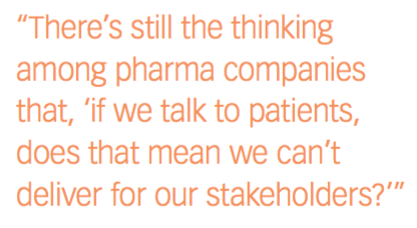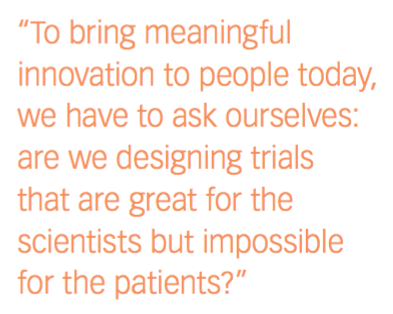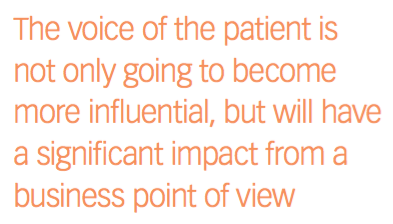The Quest for Meaningful Pharma-Patient Dialogue
With the patient voice growing louder in all aspects of the drug development and commercialization journey, Pharm Exec examines some of the current industry thinking on the evolving pharma-patient relationship.
The patient voice is growing louder in all aspects of the drug development and commercialization journey. Pharm Exec examines some of the current industry thinking on the evolving pharma-patient relationship.
Over the last decade or so, patient groups have become better organized, more professional, and, not least, more vocal. As the pharmaceutical industry and regulators have acknowledged this strengthening of influence and resources, the patient has begun to have more impact on the way pharma works, particularly in health technology assessment markets. Consequently, the move to involve patients across the drug development and commercialization process-from R&D and clinical trials to promotional campaigns-is becoming an increasingly important consideration for companies committed to pursuing transformational medical innovation.
There are, of course, remaining barriers to the smooth cooperation of pharma and patient groups. A pharma company is a commercial organization, bound by regulatory restrictions and the expectations of all its stakeholders. The relationships pharma companies have with patient organizations can only advance if the right balance is struck and clearly defined boundaries are established. Historically, as Steve Wooding, head of Janssen’s global commercial and market access strategy organization, points out, there have been issues resulting from the potential of both pharma and patient organizations to use their influence inappropriately.
“The patient voice has to come through, but there needs to be a clear separation between responsibility and accountability,” Wooding told Pharm Exec. “We do need to make sure that the relationship is on an equal footing and is based around appropriate exchange of information.”
Ipsos MORI’s head of ethnography, Victoria Guyatt, notes the operational barriers to shifting further toward patient centricity. “There’s still the thinking among pharma companies that, ‘if we talk to patients, does that mean we can’t deliver for our stakeholders?’” she says. “One of the things that pharma is getting good at is the gathering of patient insights-listening on social media, for example-but embedding and pushing these insights out to the rest of the organization, the R&D teams, is still difficult. And there’s a lot of anxiety about doing the wrong thing.”
For Abeona Therapeutics’ vice president for patient advocacy, Michelle Berg, “harmonizing language and terminology” is a challenge. “It can be difficult for some individuals, or families or community members to understand the drug development practice, gene therapy and clinical trials,” she says.
The digital dilemma
Developments in digital communication have radically altered the position of patients, and there is broad consensus that the resulting empowerment has brought major improvements to the pharma-patient dialogue. From a rare disease perspective, in particular, social media and online forums have proved to be vital tools that can engage patient communities that were hitherto almost invisible.
Abeona Therapeutics focuses on developing products for severe and life-threatening rare genetic diseases, such as mucopolysaccharidosis (MPS) IIIA and IIIB, a progressive neuromuscular disease with profound CNS

involvement, which manifests in young children. Berg told Pharm Exec: “I am grateful that we have such communication tools available for families, because knowing that these are such rare diseases, there are not clusters of families in a region who can find each other and share experiences. With the advent of digital communications, families and healthcare providers have the opportunity to locate and support one another.”
A patient diagnosed with acanthamoeba keratitis, a rare amoebic infection of the cornea, told The BMJ’s Stephen Armstrong (“Social Networking for Patients,” August 10, 2016) that when she was first diagnosed, “most of the information I could find was either inaccurate or terrifying. But I found a Facebook group, with only 38 members at the time, and the relief was enormous. I was so happy to connect with someone, to share the same emotions and experiences, the same anxiety and frustration and shock in a normal, accessible way.”
Armstrong adds that online groups don’t just enable patients to share experiences and support each other. He points to research from the University of Toronto conducted in 2011 that found that the 620 groups on Facebook for breast cancer had purposes including fundraising (44.7%), raising awareness (38.1%), promoting products or services (9%), and exclusively offering support to patients or caregivers (7%).
However, Armstrong also highlights the risk of social media disseminating misleading, superfluous, or incorrect information, or being used for the promotion of dangerous or unsuitable remedies. Berg adds that “communication tools are only going to be as good as the information that is perpetuated, and a problem can be that false or inaccurate information can be perpetuated quite quickly, which can have a negative impact. That’s why it’s important for organizations to have resources available and that are committed to supporting individuals and families with rare diseases, offering resources that can serve as a fact-check against any information that might not be right.”
Marc Princen, EVP and president, international business, Allergan, reminds us that pharma is a very regulated industry. “We are talking about decision-making where trained healthcare professionals must make the right decisions,” he says. “It shouldn’t be just a free-for-all. We need to respect the regulations. It is helpful that the technology exists and people can get better informed, but professional advice and decision-making is still needed.”
Armstrong observes that “few physicians are currently using social media to talk to patients.” Indeed, for some patients, “the idea of any healthcare professionals taking part in patient groups is an anathema; many see them as private patient spaces where people can vent frustrations about treatment,” he says. If clinicians are to engage, they need to keep up to date. Armstrong spoke to one parent who explained that her daughter, who has type 1 diabetes, only uses the photo and picture-based platforms Instagram and Snapchat rather than Facebook or Twitter. She added she had “no idea” how clinicians could use these platforms even if they can understand them.
Patient-driven results
Nevertheless, the pharma-patient dialogue continues to advance, and pharma is faced with re-evaluating how to incorporate the patient view in its processes, not just to facilitate a better relationship but effectively to translate innovation into the market.
“In the old days, you had your product and you put it out there. But to bring meaningful innovation to people today, for instance, with clinical trials, we have to ask ourselves: are we designing trials that are great for the scientists but impossible for the patients?” says Wooding. “The latter will ultimately delay access and commercialization of your medicine. And what endpoints do we need? Whether a treatment shrinks a tumor, for example, is a useful endpoint from a regulatory standpoint; but it may not be enough from a patient standpoint, if they don’t feel better or their quality of life is not improved along with the medical benefit.”
These are the criteria, says Wooding, that payers are starting to look at, “so we have an opportunity now to build those metrics into the process in a meaningful way.”
In many cases, symptomatic relief is more important to patients than outcome improvements in the long run. With payers in the past having valued outcome improvements higher than symptomatic improvements, it has become clear that the patient voice needs to be drawn further into the debate. As Pharm Exec’s Jill Wechsler noted in her April column, FDA is now looking to improve communications with patients by forming an Office

of Patient Affairs in the Office of the Commissioner. “This would provide a single, central entity to handle inquiries from the patient community, and would expand the current patient team in FDA’s Office of Health and Constituent Affairs,” she wrote.
From the industry side, building meaningful relationships with patient groups is less a case of responding to patient lobbying and more a case of encouraging them “to share with us what is important to them so that we can actually make those developments,” says Wooding.
Princen, who was formerly Takeda’s president of Europe and Canada, notes that it is about finding out “how you can institutionalize working with the patient.” He says that Takeda worked with an outside think tank, which put together criteria for inflammatory bowel disease, Crohn’s disease and ulcerative colitis. “We developed an app that included these criteria, allowing for collection of data on symptoms, triggers and aggravating factors, and provided it to patient organizations,” he says. “This type of objective criteria-setting is really useful, and it is where the patient organizations are very helpful. The next step was to work with the payers, measuring the real patient outcomes and then work out how the funding could be shared.”
So, what does pharma look for from a patient group to facilitate an effective collaboration? Ideally, according to Wooding, it’s the ability to connect with a large unifying group.
“But that isn’t always possible,” he says. “It is certainly an advantage if they have a depth of scientific knowledge. They should be informed and have a clear structure that we can interact with; they need to have the right charter in place and to be professionally operated.”
Wooding adds that, in specialty areas, particularly in diseases with increasingly complex treatments and where the side effects need to be managed effectively, “effective partnering is easier with a better informed, better aligned patient.”
For Berg, “it’s very important to collaborate and partner with those specific communities that we are aiming to serve, in order to step into their shoes and understand the impact of what that disease might be, not only for the individuals afflicted but, in the case of much of what we’re working on, in the pediatric population.” She believes that understanding what’s important to the parents and caregivers is critical and, in some cases, may be more important than understanding the priorities of the children themselves. “Because with these diseases, their voices are not really able to be heard,” says Berg.
A measure of how important patient input is perceived in the rare disease area is highlighted by results of a survey of over 3,000 US patients and caregivers across several hundred diseases and conditions, conducted this year by Rare Patient Voice. The survey found that the majority of respondents (55%) were in favor of patient advocacy groups partnering with pharma or biotechnology companies to develop drugs for medical conditions. Some of those who support partnerships stressed that they can enable drug development to take patient perspectives into account; that they are the best way to obtain funding; that they can accelerate the development of treatments; and that, ultimately, “anything that might help obtain a cure or improvement should be tried.”
Writing on the Clinical Trials Arena website, Horizon Pharma’s Dr. Jeffrey Sherman, in an article published late last year, emphasizes that “engaging with patient groups to understand the patient voice from the beginning of research can greatly benefit overall drug development.” Sherman outlines how, for a clinical trial evaluating a medicine for the treatment of Friedreich’s ataxia (FA), a rare neuromuscular disorder, Horizon collaborated from the outset with the patient organization Friedreich’s Ataxia Research Alliance (FARA).
“FARA offered crucial input on trial design to ensure that travel requirements, medicine administration and study eligibility criteria were realistic within the FA community,” he notes. “Moreover, FARA provided full access to its comprehensive patient registry, the only collection of demographic and clinical information for 2,000-plus FA patients around the world.”
The result was that the FA study completed enrollment in less than one year, “an unusually fast pace for a rare disease trial.”
An expanding opportunity
While Wooding acknowledges that, in terms of involving patients, “there are only so many things that you can choose to do within an R&D setting,” he points out that Janssen’s move in this direction has begun to deliver results for the company in the last couple of years.
“We are now starting to see patient-reported outcomes become acceptable in terms of registration and licensing and labeling,” says Wooding. “For example, for a prostate cancer medicine, we now have within the indication the fact that the drug can have an impact on pain. For most patients, that is their most relevant day-to-day symptom. Those kinds of things are working their way through into labels. The only way for a company to anticipate what’s important to patients is to have their input. With the availability of more data, to link to the

genotype and phenotype, this will become even more of an opportunity.”
Wooding concludes: “We have always been a patient-oriented company, highly aware that patients are waiting. We realize, however, that not only are patients waiting, they are engaging and wanting to take more control of their own destinies.”
It is very clear, he says, that the voice of the patient is not only going to become more influential, but will have a significant impact from a business point of view. “At Janssen, we heard it,” says Wooding. “Now we needed to do something about it. Some of that is about best practice sharing; some is about spreading the message within our organization. In other cases, it’s about trying out new approaches and seeing what works. It’s about continuing the patient dialogue-and learning from it.”

Julian Upton is Pharm Exec’s European and Online Editor. He can be reached at julian.upton@ubm.com

Addressing Disparities in Psoriasis Trials: Takeda's Strategies for Inclusivity in Clinical Research
April 14th 2025LaShell Robinson, Head of Global Feasibility and Trial Equity at Takeda, speaks about the company's strategies to engage patients in underrepresented populations in its phase III psoriasis trials.
The Misinformation Maze: Navigating Public Health in the Digital Age
March 11th 2025Jennifer Butler, chief commercial officer of Pleio, discusses misinformation's threat to public health, where patients are turning for trustworthy health information, the industry's pivot to peer-to-patient strategies to educate patients, and more.
Pfizer Discontinues Development of Danuglipron for Chronic Weight Management
April 15th 2025Despite meeting key pharmacokinetic goals, a potential case of drug-induced liver injury led Pfizer to conclude that danuglipron’s risk-benefit profile did not support further development for chronic weight management.